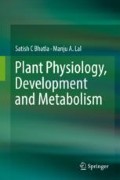Abstract
The life cycle of all seed plants can be divided into three main stages: embryogenesis, vegetative growth, and reproductive development. During embryogenesis, the single-celled zygote follows a defined pattern of cell divisions and differentiation to form the mature embryo and eventually the seedling, which contains all tissues and organs that develop into the mature plant body. In angiosperms, early phase of the embryogenesis is marked by laying down of the basic body plan of embryo, including establishment of apical—basal polarity and formation of embryonic organs (root and shoot primordial, cotyledons, etc.) and embryonic tissue layers. The embryonic layers- protoderm, ground meristem, and procambium, are the progenitors of the future epidermal, cortical, and vascular tissues, respectively. At the end of embryogenesis phase, several physiological changes occur within the embryos enabling them to sustain the period of dormancy and adverse environmental conditions. Upon the availability of factors like ambient moisture, light, temperature, etc., the seeds germinate, and with accompanying mobilization of stored reserves, the vegetative development commences, wherein tissue primordia in the seedlings grow and cells differentiate. During this period, the meristematic zones corresponding to shoot and root become active. Seedlings display a simple body plan which consists of shoot meristem, cotyledons, hypocotyl, root, and root meristem along the apical-basal axis and a concentric arrangement of tissues along the radial axis: epidermis at the periphery and subepidermal ground tissue and conductive tissue in the center. Vegetative growth is typically indeterminate, i.e., with no definite end and characterized by development of lateral organs—the leaves. As the plant undergoes the transition to reproductive development, the shoot apical meristem (SAM) changes shape, becoming an inflorescence meristem, and gives rise to flowers or flowering shoots, thus acquiring a determinate growth pattern. Plants exhibit variations in size ranging from a few mm to several hundred meters acquiring the architecture that is suited to the local environment. They grow in size throughout their lives and produce new organs like leaves, flowers, fruits, etc. The growth of plants is defined in terms of increase in number of cells as well as an increase in size of cells. It is important to note that this growth is not in terms of increase in dry mass as up to 95% of plant cells is made up of water. Plant growth is accompanied with differentiation of cells, tissues (histogenesis), and organs (organogenesis) that are specialized structures with distinct functions. Thus, growth and differentiation result in morphogenesis with the plant acquiring an overall form.
Access this chapter
Tax calculation will be finalised at checkout
Purchases are for personal use only
Suggested Further Readings
Fosket DE (1994) Plant growth and development- a molecular approach. Academic, San Diego
Howell SH (1998) Molecular genetics of plant development. Cambridge University Press, Cambridge
Raghavan V (1997) Molecular embryology of flowering plants. Cambridge University Press, Cambridge
Author information
Authors and Affiliations
Multiple-Choice Questions
Multiple-Choice Questions
-
1.
Which of the following statements is false about the polarity of an embryo?
-
(a)
It is a term used to describe the differences along an axis such that one end of the axis is different from the other.
-
(b)
It is established only after the zygote divides.
-
(c)
It is important for development of structural axis of the body.
-
(d)
It is key to biological pattern formation.
-
(a)
-
2.
The body plan of plant is distinguished by the ________pattern.
-
(a)
Apical, basal
-
(b)
Radial, apical
-
(c)
Apical-basal, radial
-
(d)
Apical-radial, basal
-
(a)
-
3.
Growth and development of a plant body are the result of:
-
(a)
Differentiation
-
(b)
Cell division and enlargement
-
(c)
Morphogenesis
-
(d)
All of the above
-
(a)
-
4.
Which of the following developmental mutants of Arabidopsis will lack both the apical and basal regions including the cotyledons and the root and so consist of a cellular mass with no obvious signs of apical-basal polarity?
-
(a)
GNOM
-
(b)
GURKE
-
(c)
MONOPTEROS.
-
(d)
FACKEL
-
(a)
-
5.
The hormone that provides positional information for the coordination of correct cellular patterning from the globular stage onward:
-
(a)
Cytokinin
-
(b)
Gibberellin
-
(c)
Auxin
-
(d)
Ethylene
-
(a)
-
6.
SHR (short root) and SCR (scarecrow) are involved in:
-
(a)
Ground tissue development
-
(b)
Apical-basal pattern
-
(c)
RAM development
-
(d)
Establishment of polarity
-
(a)
-
7.
PIN-mediated auxin flow in the SAM directs auxin to:
-
(a)
Regions that flank SAM
-
(b)
Central zone
-
(c)
Rib zone
-
(d)
Leaf primordia
-
(a)
-
8.
Antagonistic activity of the following two hormones in the basal cell is essential for normal development of RAM and enables the particular pattern of cell divisions that occur in the QC.
-
(a)
Cytokinin and gibberellin
-
(b)
Auxin and ethylene
-
(c)
Gibberellin and auxin
-
(d)
Cytokinin and auxin
-
(a)
-
9.
Characteristic feature that distinguishes the development of a dicot embryo from a monocot embryo:
-
(a)
Asymmetric division of the zygote
-
(b)
Octant stage
-
(c)
Establishment of bilateral asymmetry
-
(d)
SAM is established at a lateral position opposite to the scutellum
-
(a)
-
10.
The cell wall proteins that are activated by acidification and disrupt noncovalent binding between cellulose and hemicelluloses:
-
(a)
Cellulases
-
(b)
Hemicellulases
-
(c)
Expansins
-
(d)
Pectinases
-
(a)
Answers
1. b | 2. c | 3. d | 4. a | 5. c | 6. a | 7. a | 8. d | 9. d | 10. c |
Rights and permissions
Copyright information
© 2018 Springer Nature Singapore Pte Ltd.
About this chapter
Cite this chapter
Sisodia, R., Bhatla, S.C. (2018). Embryogenesis, Vegetative Growth, and Organogenesis. In: Plant Physiology, Development and Metabolism. Springer, Singapore. https://doi.org/10.1007/978-981-13-2023-1_24
Download citation
DOI: https://doi.org/10.1007/978-981-13-2023-1_24
Published:
Publisher Name: Springer, Singapore
Print ISBN: 978-981-13-2022-4
Online ISBN: 978-981-13-2023-1
eBook Packages: Biomedical and Life SciencesBiomedical and Life Sciences (R0)

